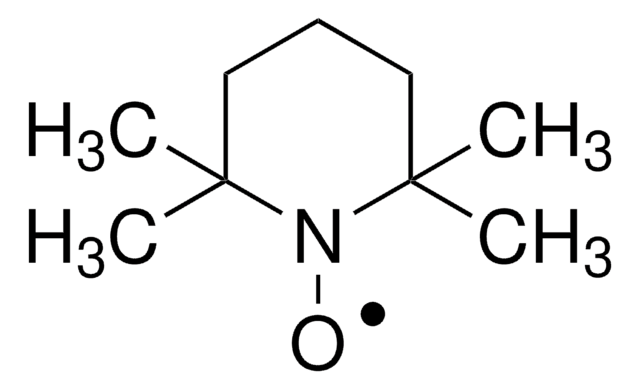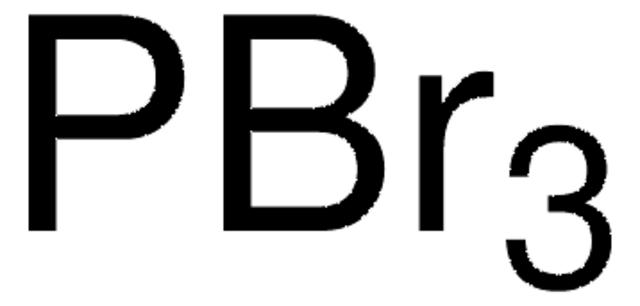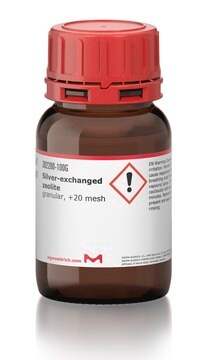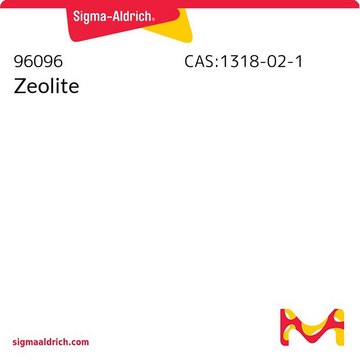Key Documents
793574
Sodium bromide
anhydrous, free-flowing, Redi-Dri™, ACS reagent, ≥99%
About This Item
Polecane produkty
klasa czystości
ACS reagent
anhydrous
Poziom jakości
ciśnienie pary
1 mmHg ( 806 °C)
linia produktu
Redi-Dri™
Próba
≥99%
Postać
powder
jakość
free-flowing
zanieczyszczenia
≤0.005% insolubles
pH
5.0-8.8 (25 °C, 5%)
mp
755 °C (lit.)
ślady anionów
bromate (BrO3-): ≤0.001%
chloride (Cl-): ≤0.2%
sulfate (SO42-): ≤0.002%
ślady kationów
Ba: ≤0.002%
Ca: ≤0.002%
Fe: ≤5 ppm
K: ≤0.1%
Mg: ≤0.001%
heavy metals: ≤5 ppm (by ICP-OES)
ciąg SMILES
[Na+].[Br-]
InChI
1S/BrH.Na/h1H;/q;+1/p-1
Klucz InChI
JHJLBTNAGRQEKS-UHFFFAOYSA-M
Szukasz podobnych produktów? Odwiedź Przewodnik dotyczący porównywania produktów
Opis ogólny
Zastosowanie
- Sensitive and Low-Noise Perovskite Nanocrystal-Organic Bulk Heterostructure X-ray Detectors Enabled by Sodium Bromide-Assisted In Situ Reparation: This research underscores the role of sodium bromide in enhancing the fabrication of perovskite nanocrystals for advanced X-ray detection technologies, illustrating its utility in high-precision imaging applications critical for both medical and industrial use (Li Y, Fang Y, 2024).
- Surface-Modified Carboxylated Cellulose Nanofiber Hydrogels for Prolonged Release of Polyhexamethylene Biguanide Hydrochloride (PHMB) for Antimicrobial Applications: Demonstrates the effectiveness of sodium bromide in modifying cellulose nanofibers for use in sustained drug release systems, highlighting its importance in the development of antimicrobial materials (O-Chongpian P, Jantrawut P, 2023).
- Unravelling Alkali-Metal-Assisted Domain Distribution of Quasi-2D Perovskites for Cascade Energy Transfer toward Efficient Blue Light-Emitting Diodes: Details the utilization of sodium bromide in the synthesis of quasi-2D perovskites, paving the way for improvements in blue light-emitting diode (LED) technology which is crucial for display and lighting solutions (Cai W, Yip HL, 2022).
- Chronic sodium bromide treatment relieves autistic-like behavioral deficits in three mouse models of autism: Highlights the potential therapeutic applications of sodium bromide in neuropsychiatric disorders, providing insights into its efficacy in alleviating symptoms of autism within experimental settings (Derieux C, Becker JAJ, 2022).
- Development of Flexible Plasticized Ion Conducting Polymer Blend Electrolytes Based on Polyvinyl Alcohol (PVA): Chitosan (CS) with High Ion Transport Parameters Close to Gel Based Electrolytes: Showcases the role of sodium bromide in the development of high-performance polymer electrolytes for energy storage applications, demonstrating its impact on enhancing ion transport properties (Sadiq NM, Kadir MFZ, 2022).
Informacje prawne
Hasło ostrzegawcze
Warning
Zwroty wskazujące rodzaj zagrożenia
Zwroty wskazujące środki ostrożności
Klasyfikacja zagrożeń
Repr. 2 - STOT RE 2 - STOT SE 3
Organy docelowe
Central nervous system
Kod klasy składowania
13 - Non Combustible Solids
Klasa zagrożenia wodnego (WGK)
WGK 1
Temperatura zapłonu (°F)
Not applicable
Temperatura zapłonu (°C)
Not applicable
Wybierz jedną z najnowszych wersji:
Masz już ten produkt?
Dokumenty związane z niedawno zakupionymi produktami zostały zamieszczone w Bibliotece dokumentów.
Klienci oglądali również te produkty
Produkty
Redi-Dri™ zapobiega wchłanianiu wilgoci i tworzeniu się grudek przez higroskopijne proszki, takie jak sole nieorganiczne, pozostawiając za każdym razem sypkie sole.
Nasz zespół naukowców ma doświadczenie we wszystkich obszarach badań, w tym w naukach przyrodniczych, materiałoznawstwie, syntezie chemicznej, chromatografii, analityce i wielu innych dziedzinach.
Skontaktuj się z zespołem ds. pomocy technicznej











